Easter Bunny Check: Mixed Sustainability Picture, Calls for Clearer Labels
The Easter Bunny Check, conducted by environmental and human rights groups, has revealed a mixed picture of chocolate Easter bunnies' sustainability. While some brands excelled, others fell short, highlighting the need for clearer labeling and government intervention.
Out of 36 tested bunnies, 6 carried both the Fairtrade and EU organic seals, demonstrating commitment to fair and ecological practices. However, 8 bunnies failed to meet any sustainability standards, indicating significant room for improvement.
The range of certified bunnies has expanded over the years, with winners including EZA, Billa Bio, and Spar's Natur Pur Bio-Osterhasen. Yet, some independently certified products do not display seals on packaging, making it challenging for consumers to recognize sustainability efforts.
Most cocoa beans used by Austrian companies originate from Ghana and the Ivory Coast, where child labor and low incomes persist. Large companies like Lindt and Mondelez received a 'double red' rating for relying on in-house sustainability initiatives instead of independent certifications.
The Easter Bunny Check underscores the need for mandatory ecological and social standards, as advocated by the federal government. Clearer labeling would also empower consumers to make informed choices. While progress has been made, the industry must strive for more transparency and commitment to sustainability.
Read also:
- Germany's Water Crisis: 10 Billion Cubic Meters Lost Annually
- AI Transforms Urban Planning: Zurich, Vienna Lead the Way
- Beachgoers should be aware that potentially lethal "flesh-consuming bacteria" can survive in coastal environments. Here are safety precautions to follow.
- Soil-to-Plant Expedition: The Ionic Trek







